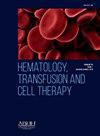淋巴系统恶性肿瘤car - t细胞治疗后多发性神经根病的诊断挑战:附3例报告
IF 1.6
Q3 HEMATOLOGY
引用次数: 0
摘要
目的神经毒性是CAR - t细胞治疗的一个严重但尚未完全了解的并发症。在这里,我们强调非中枢神经系统CAR - t细胞治疗并发症的表现和诊断挑战。病例系列病例1:一名43岁女性复发的DLBCL IVB期,未累及中枢神经系统,接受了轴细胞CAR - t细胞治疗,对托珠单抗有反应,出现I级CRS。第15天,出现复视和第6神经麻痹,MRI提示中枢神经系统淋巴瘤浸润,使用地塞米松和鞘内MTX治疗,第30天PET扫描显示CMR。随后,她出现四肢无力,肌电图/神经突触图证实多发性神经根病脑脊液显示高蛋白,但感染、恶性细胞和自身免疫均阴性。治疗包括甲基强的松龙,血浆置换和IVIG,导致轻微改善。第60天PET-CT显示颈椎和腰椎神经根神经炎,第90天活检证实疾病复发。她对格非他单抗有部分反应,不幸的是,她在car - t细胞治疗四个月后去世了。病例2:一名38岁男性原发性难治性III期DLBCL患者在流感/Cy淋巴细胞清除后接受了axis - cel治疗。第1天,发生I级CRS,并接受托珠单抗和地塞米松治疗。第4天,患者表现为ICANS IV级,神志不清和癫痫发作,使用甲基强的松龙、阿那金和劳拉西泮治疗。脑脊液显示高蛋白,但未见感染和恶性细胞。MRI提示病毒性脑炎,开始使用阿昔洛韦。第8天拔管,但出现下肢无力(0/5功率)和尿潴留。脊髓MRI显示髓内T2改变。第11天给予IVIG,并开始物理治疗。到了16日,他能站起来了;第29天MRI恢复正常。第32天的PET-CT显示非常好的部分反应。患者能够行走,并于第39天出院,持续康复。病例3:一名36岁男性,CML转化为b细胞ALL并累及中枢神经系统,三次IT化疗难治性,接受IT硫替帕治疗,并发下肢无力和括约肌丧失。NCS证实L5神经根病;MRI和CSF未见母细胞或中枢神经系统疾病。brexus - cell输注后(+5至+7天),患者出现CRS I级,接受Tocilizumab治疗,随后下肢无力和感觉丧失恶化。MRI示马尾脑膜新强化;NCS证实双侧多发性神经根病。脑脊液显示高蛋白,但未见细胞或感染。IVIG、甲基强的松龙、阿那金和甲氧基氢化可的松均可改善症状。第30天的MRI评估为阴性,重复MRI脑和脊柱显示薄脑膜增强消退。结论随着CAR - t细胞疗法应用的增加,出现了一些罕见的副作用,如感觉-运动多神经根病。这些病例强调了诊断和管理非中枢神经系统神经毒性的挑战。早期识别、量身定制的干预措施和多学科护理至关重要,同时需要进一步研究以更好地了解机制并改善患者的预后。本文章由计算机程序翻译,如有差异,请以英文原文为准。
POLYRADICULOPATHY FOLLOWING CAR T-CELL THERAPY FOR LYMPHOID MALIGNANCIES, DIAGNOSTIC CHALLENGES: A REPORT OF 3 CASES
Objective
Neurotoxicity is a serious but incompletely understood complication of CAR T-cell therapy. here we highlight presentation and diagnostic challenges of non-CNS CAR T-cell therapy complication.
Case series
Case 1: A 43-year-old female with relapsed DLBCL stage IVB without CNS involvement underwent Axi-Cel CAR T-cell therapy, developing grade I CRS responded to tocilizumab. On day +15, developed diplopia and 6th nerve palsy MRI suggestive CNS lymphomatous infiltration, managed with dexamethasone and intrathecal MTX with a PET scan on day 30 showing CMR. Subsequently, she had limbs weakness with EMG/NCS confirming polyradiculopathy CSF showing high protein but negative for infection, malignant cells and autoimmune. Treatment included methylprednisolone, plasmapheresis, and IVIG, leading to slight improvement. Day 60 PET-CT revealed cervical and lumbar nerve roots neuritis, and by day 90, biopsy-confirmed disease relapse. She had partial response to glofitamab, unfortunately, she passed away four months post-CAR T-cell therapy.
Case 2: A 38-year-old male with primary refractory stage III DLBCL received Axi-Cel after lymphodepletion with Flu/Cy. On day +1, grade I CRS developed and was treated with tocilizumab and dexamethasone. By day +4, he exhibited ICANS grade IV with confusion and seizures, managed with methylprednisolone, anakinra, and lorazepam. CSF showed high protein but no infection or malignant cells. MRI suggested viral encephalitis, and acyclovir was started. Extubated on day +8, but showed lower limb weakness (0/5 power) and urinary retention. Spinal MRI showed intramedullary T2 changes. IVIG was given on day +11, and physical therapy started. By day +16, he could stand; MRI normalized by day +29. PET-CT on day +32 showed a very good partial response. The patient was able to walk and discharged on day +39 with ongoing recovery.
Case 3: A 36-year-old male with CML transformed to B-cell ALL with CNS involvement refractory to triple IT chemotherapy received IT thiotepa, complicating with lower limb weakness and sphincter loss. NCS confirmed L5 radiculopathy; MRI and CSF were negative for blasts or CNS disease. Post-Brexu-cel infusion (day +5 to +7), he developed CRS grade I, treated with Tocilizumab, followed by worsening lower limb weakness and sensory loss. MRI revealed new cauda equina leptomeningeal enhancement; NCS confirmed bilateral polyradiculopathy. CSF showed high protein but no blasts or infections. IVIG, methylprednisolone, anakinra and IT MTX-hydrocortisone improved symptoms. MRD assessment on day +30 was negative repeated MRI brain and spine showed resolution of leptomeningeal enhancement.
Conclusion
With the increasing use of CAR T-cell therapy, rare side effects, such as sensory-motor polyradiculopathy, are emerging. These cases underscore the challenges of diagnosing and managing non-CNS neurotoxicity. Early recognition, tailored interventions, and multidisciplinary care are vital, while further research is needed to better understand mechanisms and improve patients’ outcomes.
求助全文
通过发布文献求助,成功后即可免费获取论文全文。
去求助
来源期刊

Hematology, Transfusion and Cell Therapy
Multiple-
CiteScore
2.40
自引率
4.80%
发文量
1419
审稿时长
30 weeks
 求助内容:
求助内容: 应助结果提醒方式:
应助结果提醒方式:


